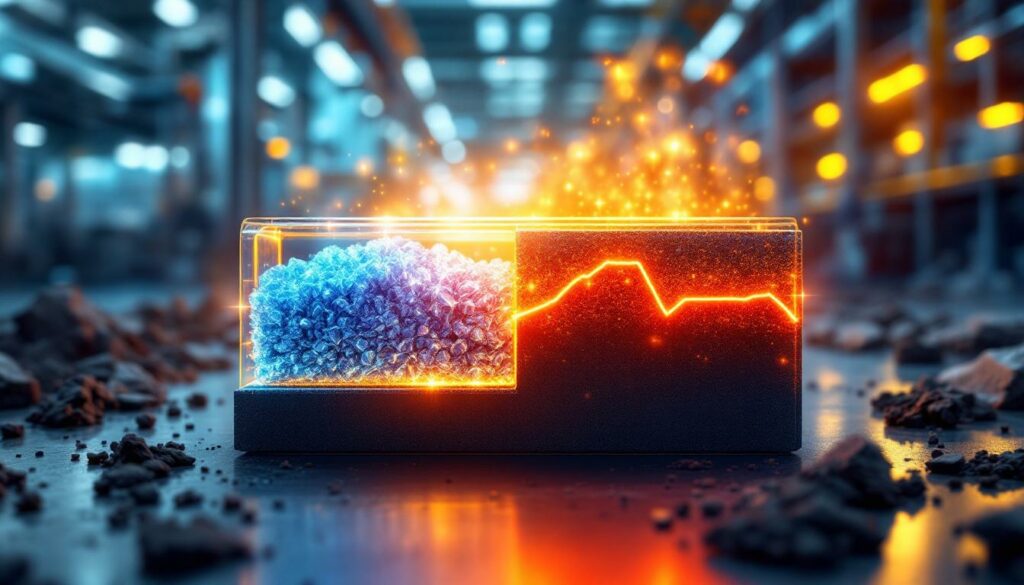What Is Causing the Stabilization of Artificial Graphite Anode Prices?
The lithium battery industry has recently witnessed a notable shift in the artificial graphite anode market, with prices stabilizing after a period of volatility. This stabilization represents a significant development for battery manufacturers, electric vehicle producers, and energy storage companies who rely on predictable component costs for strategic planning.
Market Forces Creating Equilibrium
Several interconnected factors have contributed to the current price stability in the artificial graphite anode segment:
Balanced demand dynamics are playing a crucial role in market stabilization. According to recent SMM (Shanghai Metals Market) data, the small energy storage sector has shown modest recovery, effectively offsetting the demand gap created by the slowdown in New Energy Vehicle (NEV) production. This diversification of demand sources has helped maintain overall volume requirements despite individual sector fluctuations.
Supply conditions have evolved significantly from previous quarters. While production capacity remains abundant throughout the supply chain, the aggressive expansion seen in recent years has moderated. Manufacturers have adjusted their capacity growth plans in response to market realities, creating a more balanced supply-demand equation.
"The small energy storage market saw a slight recovery, which, to a certain extent, offset the demand gap caused by the slowdown in production speed in the NEV market," notes SMM's July 2025 market report.
Perhaps most significantly, raw material costs have reached an inflection point. After an extended period of decline that put pressure on anode prices, key input materials have halted their downward trajectory and begun rebounding. This cost foundation provides effective support for artificial graphite pricing, establishing a natural floor below which producers cannot sustainably operate.
The industry's structural overcapacity continues to act as a ceiling for significant price increases. Despite stabilizing factors, the substantial production capacity built during previous expansion cycles means manufacturers cannot easily implement major price hikes without risking market share.
Cost Structure Analysis
A detailed examination of the artificial graphite anode cost structure reveals why prices have found their current equilibrium:
Raw material dynamics have become the primary price stabilizer. The petroleum coke and coal tar pitch used in artificial graphite production represent 50-60% of total production costs. As these input prices have firmed, they've created an effective floor for finished anode pricing—manufacturers simply cannot reduce prices below certain thresholds without operating at a loss.
Production efficiency improvements have allowed manufacturers to maintain viable margins despite continued pricing pressures. Innovations in graphitization processes, heat treatment optimization, and energy efficiency have offset some cost pressures without necessitating price increases to maintain profitability.
Technological advancement is enabling cost optimization without corresponding price reductions. Enhanced particle engineering, surface treatment methods, and quality control processes are delivering higher-performing products at similar cost structures, allowing manufacturers to maintain price points while offering improved value.
The combination of these factors has created a relatively stable pricing environment that industry participants expect to continue in the near term, barring major supply chain disruptions or demand shocks.
How Do Natural Graphite Anodes Compare in the Current Market?
While prices of artificial graphite anodes stabilize, the market for natural graphite anodes tells a different story, highlighting the divergent trajectories of these two key battery materials.
Downward Pressure on Natural Graphite Anode Prices
Natural graphite anode manufacturers face more challenging market conditions than their artificial graphite counterparts. Several factors contribute to this downward pressure:
Supply-demand imbalance is more pronounced in the natural graphite sector. Production capacity expanded rapidly in anticipation of continued battery market growth, but demand hasn't kept pace with available supply. This mismatch has created persistent downward price pressure that shows few signs of abating.
Technological competition from artificial graphite has intensified. As artificial graphite manufacturers have improved their production efficiency and performance characteristics, the traditional cost advantage of natural graphite has eroded. Battery manufacturers increasingly opt for artificial materials that offer more consistent quality and better performance predictability.
The expansion of silicon-carbon alternatives further complicates the competitive landscape. SMM market data indicates that vapor deposition silicon-carbon producers are steadily increasing their production capacity, with new facilities coming online throughout 2025. These advanced materials offer performance advantages that make them increasingly attractive to premium battery segments.
- Vapor deposition silicon-carbon composites provide higher energy density
- Production capacity increases are gradually flooding the market
- Performance benefits justify price premiums for certain applications
Shifting Customer Preferences
Downstream battery manufacturers and EV producers have adjusted their procurement strategies in ways that impact natural graphite demand:
Cost reduction initiatives remain paramount for many manufacturers, particularly those serving mass-market vehicle segments. However, these efforts increasingly focus on system-level optimization rather than simple component price minimization, sometimes favoring higher-cost materials that enable overall battery cost reductions through performance improvements.
Performance enhancement requirements continue to grow more stringent as EVs transforming mining and battery industries compete on range, charging speed, and battery longevity. Natural graphite faces challenges meeting these escalating specifications without significant processing investments that erode its cost advantage.
The combination of these factors has created a situation where the market space for natural graphite anodes is potentially shrinking. As one industry analyst noted, "Natural graphite faces a fundamental dilemma—invest heavily in processing to match artificial graphite performance but lose cost advantage, or maintain cost position but fall behind on specifications."
Battery manufacturers increasingly adopt a multi-material strategy, using artificial graphite for premium applications and natural graphite for cost-sensitive segments. However, this segmentation may be unsustainable as performance expectations rise across all price points.
What Are the Key Technological Developments Affecting the Anode Market?
The battery anode landscape is undergoing rapid technological evolution, with developments in multiple material categories reshaping competitive dynamics and influencing pricing trends.
Innovation Acceleration in Artificial Graphite
The artificial graphite sector has entered a period of intensified technological advancement:
Manufacturing process optimization has accelerated significantly, with producers implementing enhanced graphitization techniques that improve crystalline structure while reducing energy consumption. These innovations deliver higher-performance materials without proportional cost increases, strengthening artificial graphite's value proposition.
Performance improvements are making artificial options increasingly attractive across a wider range of applications. Recent iterations offer:
- Higher reversible capacity (approaching 360-370 mAh/g)
- Improved first-cycle efficiency (reaching 92-94%)
- Enhanced rate capability for fast-charging applications
- Better cycle stability in extreme temperature conditions
Cost-efficiency gains have been achieved through manufacturing process refinements. Innovations in high-temperature treatment methods, particle engineering, and quality control systems have reduced production costs while maintaining or improving performance metrics.
Energy density enhancements are attracting premium market segments that previously considered only advanced materials like silicon composites. The latest artificial graphite formulations deliver energy density improvements that make them viable for high-performance applications while maintaining better cycle stability than silicon-heavy alternatives.
Silicon-Carbon Composite Expansion
Silicon-carbon composite anodes represent the industry's next technological frontier, with significant market developments underway:
Production capacity expansion is occurring rapidly among vapor deposition silicon-carbon producers. Multiple manufacturers are commissioning new facilities designed specifically for these advanced materials, suggesting confidence in growing demand despite higher production costs.
New manufacturing approaches are reducing the historical challenges associated with silicon anodes. Vapor deposition techniques allow precise control of silicon content and distribution, mitigating the volume expansion issues that plagued earlier silicon-based materials.
Performance advantages of silicon-carbon composites are compelling for specific applications:
- Theoretical capacity up to 3-4 times higher than graphite alone
- Practical implementations achieving 500-600 mAh/g in commercial cells
- Potential for significant range improvements in premium electric vehicles
- Faster charging capabilities than traditional graphite anodes
Integration potential with existing battery technologies makes these materials particularly attractive. Silicon-carbon composites can be incorporated into established cell designs with minimal process adjustments, allowing manufacturers to improve performance without completely redesigning their production lines.
These technological developments are creating a more stratified anode market, with different materials targeting specific application segments based on their performance characteristics and cost structures.
What Market Factors Are Supporting Price Stability?
Multiple interconnected market dynamics have converged to create the current stable pricing environment for artificial graphite anodes, while simultaneously putting pressure on natural graphite alternatives.
Supply-Side Dynamics
On the supply side of the equation, several factors contribute to the current market balance:
Raw material cost stabilization has provided a crucial pricing floor. After extended declines, the key inputs for artificial graphite production—petroleum coke and coal tar pitch—have halted their downward trajectory and begun modest recoveries. This cost structure makes further price reductions unsustainable for producers.
Production capacity expansion has slowed considerably compared to previous periods. After years of aggressive growth that created significant overcapacity, manufacturers have moderated their expansion plans. While abundant capacity still exists, the rate of new additions has decreased substantially, preventing further supply-demand imbalance.
Manufacturing efficiency improvements continue to balance cost pressures. Producers have implemented process optimizations that reduce energy consumption, improve yield rates, and enhance automation, allowing them to maintain margins without raising prices despite input cost increases.
Supply chain adjustments have improved manufacturers' ability to accommodate changing demand patterns. More sophisticated inventory management and production planning systems allow producers to respond more nimbly to market shifts without the boom-bust cycles that previously characterized the industry.
Demand-Side Influences
On the demand side, several developments have created a more balanced market environment:
Small energy storage market recovery has emerged as a significant counterbalance to slowing NEV production. Residential, commercial, and utility-scale energy storage installations have increased in key markets, creating diversified demand for battery materials that reduces dependence on electric vehicle production cycles.
Application diversification has created more balanced overall demand. Beyond electric vehicles and energy storage, growing markets for electric tools, personal mobility devices, and industrial equipment have expanded the customer base for battery materials, reducing vulnerability to disruptions in any single sector.
Seasonal purchasing patterns have normalized after pandemic-related disruptions. Battery and EV manufacturers have returned to more predictable procurement cycles, allowing anode producers to plan production more effectively and avoid the feast-or-famine conditions that contributed to previous price volatility.
Regional demand variations have created a more balanced global market. While some regions experience slowdowns, others show growth, creating a more stable overall demand picture that supports price consistency.
The interplay between these supply and demand factors has created a market environment where artificial graphite anode prices have found equilibrium, at least for the near term.
What's the Short-Term Outlook for Anode Material Prices?
Industry analysts and market participants have developed reasonably consistent expectations for anode material pricing trends over the coming months, though significant uncertainties remain in this dynamic market.
Artificial Graphite Price Projections
For artificial graphite anodes, the consensus points toward continued stability:
Current price levels appear sustainable in the near term. The combination of raw material cost support, balanced supply-demand dynamics, and established customer relationships suggests artificial graphite prices are likely to hold within their current range barring major market disruptions.
Raw material cost trends continue to provide fundamental support. With petroleum coke and coal tar pitch prices stabilizing and showing modest recovery, the cost foundation for artificial graphite production remains firm, preventing significant downward pressure.
The industry's overcapacity situation remains difficult to resolve quickly. Despite slowed expansion, the substantial production capacity built during previous growth cycles continues to create a ceiling for significant price increases. Manufacturers know that aggressive pricing could prompt customers to shift volumes to competitors with available capacity.
Technological improvements may offset potential downward price pressure. As manufacturers continue enhancing their products' performance characteristics, they can maintain value propositions and price points even in a competitive market environment.
According to SMM market analysis, these factors collectively suggest artificial graphite anode prices will remain relatively stable through at least the third quarter of 2025, with limited potential for either significant increases or decreases.
Natural Graphite Market Challenges
The outlook for natural graphite anodes presents a more challenging picture:
Continued downward pressure appears likely for natural graphite anode prices in the near term. The combination of abundant supply, technological disadvantages relative to artificial alternatives, and competition from silicon-carbon composites creates persistent headwinds.
Technological iteration factors continue creating competitive disadvantages. As artificial graphite and silicon-carbon technologies advance, natural graphite's position becomes increasingly challenged, particularly for premium applications with stringent performance requirements.
Supply-demand pattern analysis suggests potential market share erosion. Unless natural graphite producers can significantly enhance their materials' performance characteristics or establish decisive cost advantages, they risk losing additional market share to competing materials.
Pricing competition from alternative materials will likely intensify. As silicon-carbon production capacity increases and artificial graphite efficiency improves, natural graphite producers face difficult choices between maintaining margins and preserving market share.
These trends indicate that while prices of artificial graphite anodes stabilize, natural graphite anode materials may continue facing downward pressure through 2025, with limited prospects for near-term recovery without significant technological or market developments.
How Is the Energy Storage Market Influencing Anode Demand?
The evolving energy storage landscape has emerged as a critical factor in anode material demand dynamics, providing an important counterbalance to electric vehicle market fluctuations.
Small Energy Storage Sector Recovery
The small energy storage segment has shown encouraging growth trends:
Recent market uptick in small energy storage applications has helped offset slowdowns in other sectors. According to SMM market data, this recovery has been sufficient to partially fill the demand gap created by reduced NEV production rates, contributing significantly to overall market stability.
Deployment diversification is creating new demand channels for anode materials. Beyond traditional utility-scale projects, energy storage systems are increasingly deployed in commercial buildings, residential installations, telecommunications infrastructure, and industrial facilities, each with specific battery requirements.
Residential and commercial systems often require specific anode characteristics that differ from electric vehicle applications. These systems typically prioritize cycle life and safety over maximum energy density, creating demand for anode materials optimized for longevity rather than highest possible capacity.
Growth potential in distributed energy storage appears substantial. As electricity costs rise and grid reliability concerns persist in many regions, the economic case for behind-the-meter storage continues to strengthen, suggesting sustained demand growth for battery materials serving this segment.
Energy storage systems across these applications typically use lithium-ion batteries similar to those in electric vehicles, but with different optimization priorities that influence anode material selection.
NEV Market Production Adjustments
The electric vehicle sector continues to exert significant influence on anode demand despite recent adjustments:
Production slowdowns in several major markets have affected overall anode demand. After years of explosive growth, some electric vehicle manufacturers have moderated production plans in response to economic conditions, inventory accumulation, and shifting consumer preferences.
The temporary versus structural nature of this slowdown remains debated among industry observers. Some view it as a routine adjustment in a maturing market, while others see potential longer-term challenges in consumer adoption rates and competitive dynamics.
Regional variations in electric vehicle production rates create a complex global picture. While some markets experience slowdowns, others continue growing, creating shifting geographic demand patterns for battery materials including anodes.
Premium vehicle segments maintain stronger demand than mass-market categories. High-end electric vehicles continue selling well despite economic headwinds, supporting demand for advanced anode materials that enable superior performance characteristics.
The interplay between energy storage growth and NEV market adjustments has created a more diverse demand landscape for anode materials, reducing vulnerability to disruptions in any single application category.
What Role Do Raw Materials Play in Price Stabilization?
Raw material dynamics form the foundation of anode pricing structures, with recent developments in key inputs playing a crucial role in market stabilization.
Cost Component Analysis
Understanding the cost structure of anode materials helps explain current pricing trends:
Raw material contribution to overall anode pricing varies by material type but typically represents 50-60% of production costs for artificial graphite anodes. Petroleum coke and coal tar pitch serve as the primary inputs, with their price movements directly affecting finished anode economics.
Recent price movements in these key materials have established a floor for anode pricing. After extended declines, petroleum coke and pitch prices have stabilized and begun modest recoveries, making further anode price reductions economically unsustainable for producers.
Supply chain resilience factors significantly affect material availability and pricing. Petroleum coke production is tied to oil refining activities, creating complex interdependencies between energy markets and battery material costs that manufacturers must navigate.
Processing cost considerations extend beyond raw material prices. Energy costs for high-temperature treatment, labor expenses, and environmental compliance requirements also influence overall production economics and contribute to pricing stability.
These cost components collectively create natural boundaries for anode pricing, with raw material costs establishing the effective floor below which producers cannot sustainably operate.
Supply Chain Considerations
Beyond direct costs, broader supply chain factors influence raw material dynamics and anode pricing:
Geographical distribution of raw material sources creates both opportunities and vulnerabilities. While petroleum coke and coal tar pitch are produced in multiple regions, quality variations and transportation logistics affect availability and pricing for specific grades required in anode production.
Processing capacity limitations can create bottlenecks despite raw material availability. Specialized graphitization and treatment facilities require significant investment and expertise, potentially constraining production even when basic materials are abundant.
Transportation and logistics factors affect delivered costs beyond basic material prices. Rising shipping costs, port congestion, and container availability issues can significantly impact the total landed cost of materials, influencing pricing decisions throughout the supply chain.
Inventory management strategies throughout the supply chain affect price sensitivity. Manufacturers maintaining larger material reserves can better withstand short-term price fluctuations, while those operating with minimal inventories may need to adjust pricing more rapidly in response
Ready to Catch the Next Major Mineral Discovery?
Gain a decisive market advantage with Discovery Alert's proprietary Discovery IQ model that instantly identifies significant ASX mineral discoveries, transforming complex data into actionable investment insights. Explore how major discoveries have generated substantial returns by visiting the Discovery Alert discoveries page and begin your 30-day free trial today.




